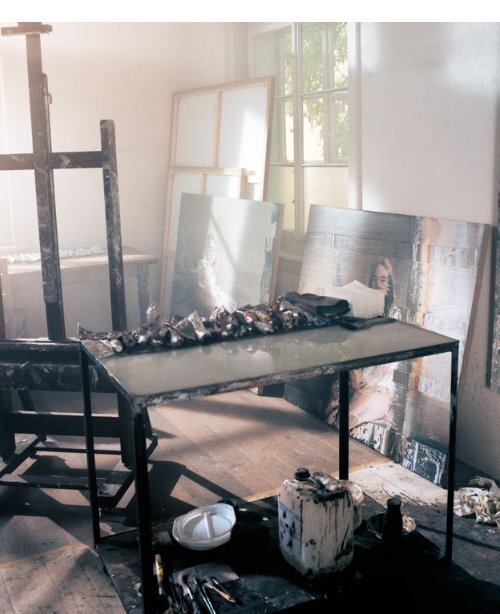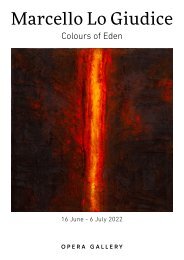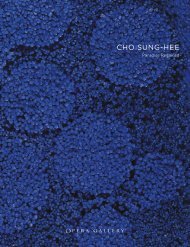ANDY DENZLER. Paintings of Disruption
ANDY DENZLER. Paintings of Disruption Opera Gallery Seoul 8 - 30 November 2019
ANDY DENZLER. Paintings of Disruption
Opera Gallery Seoul
8 - 30 November 2019
Create successful ePaper yourself
Turn your PDF publications into a flip-book with our unique Google optimized e-Paper software.
<strong>ANDY</strong> <strong>DENZLER</strong><br />
Here I see a photo taken in front <strong>of</strong> a gallery. The quickly moving viewers were captured as faint spectres.<br />
This photo mesmerises me, but not because <strong>of</strong> the visitors’ ghostlike shadows. Rather, what fascinates<br />
me is the uncanny paintings behind those passers-by. The paintings look as if someone ‘took videos <strong>of</strong><br />
people and paused them at random moments’, and they behold my gaze. At first glance, they look like<br />
Representational-Expressionist paintings based on photographs, stylised by powerful mark-making.<br />
But, with each passing moment, the paintings grow stranger and stranger. The image is as distorted as<br />
a shaky photo, out-<strong>of</strong>-focus as if it was obstructed by a veil, and no matter how hard you try to focus, it is<br />
impossible to read the expression on the people’s faces. What was the painter trying to depict?<br />
Were these done with an intention? Or is the painter trying to obscure something?<br />
Swiss-born contemporary artist Andy Denzler is the one responsible for this unique painting style.<br />
He mostly works with oil painting and takes his source images from photos and new media. Most <strong>of</strong> them<br />
are people and surroundings he had encountered in daily life, but in some works he uses a collage-like<br />
process; he disassembles various images, picks out specific people and backgrounds, and puts them<br />
together in an context. The resulting image is unpredictable and unlikely, but undoubtedly mysterious and<br />
enticing. They are scenes <strong>of</strong> reality, but the sense <strong>of</strong> unreality prevails in them. Although he approaches<br />
his paintings from the angle <strong>of</strong> representation and sources his paintings from photo and video. His works<br />
are not dominated by the human figures in them; instead, his manner and process <strong>of</strong> depicting figures are<br />
what defines his œuvre. Denzler is a traditional portrait painter in the sense that he builds layers upon<br />
layers to sculpt out the face and the body, but his tactile and instant interventions adjust and recreate his<br />
people’s identities. First, he illustrates his figure, and before the oil paint dries, he uses brush and knife to<br />
rub and push his image, blurring the outlines and boundaries. Then, he builds additional thick layers <strong>of</strong><br />
paint to reinforce the painting’s texture. Horizontal and vertical spaces are laid on top <strong>of</strong> each other; each<br />
addition further distorting the image.<br />
Glitch is a digital phenomenon caused by video playback errors, but ironically, Denzler uses the effect<br />
to point to the painterly characteristics <strong>of</strong> his canvases. The more the glitch and his paintings become<br />
that much more painterly. Representational art does provide the foundation <strong>of</strong> his creative practice, but<br />
abstractive implications are what ultimately governs his paintings. Denzler’s artistic expression is formed<br />
by these two opposing forces, representation and abstraction.<br />
His creative process alone can attest to how his paintings extend far beyond the boundaries <strong>of</strong><br />
Expressionism. This feat was possible because Denzler had constructed his artistic practice upon a<br />
meticulous aesthetic background. During interviews, he mentioned that he strives to overcome the<br />
‘slickness’ found in JPEG images and everyday life. There is something counterintuitive in this statement,<br />
for ‘slickness’ is an undeniable part <strong>of</strong> modern aesthetics. Byung-Chul Han claimed that, by the era <strong>of</strong> early<br />
modern aesthetics, ‘slickness’ had already been promoted to a core aesthetic principle (Edmund Burke).<br />
The age <strong>of</strong> mechanical reproduction soon followed, and thanks to the rapid technological advancements,<br />
visual images are far more superior even in terms <strong>of</strong> ‘slick visibility.’ Photo and video are crisp and flawless

















